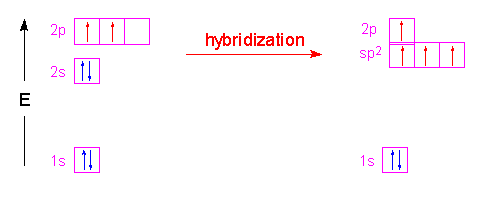

This is the same amount as the number of valence electrons they would have on their own, so they both have a formal charge of zero. The two fluorines that share single bonds with boron have seven electrons around them (six from their three lone pairs and one from their single bonds with boron). This is one less electron than the number of valence electrons it would have naturally (Group Seven elements have seven valence electrons), so it has a formal charge of +1. The fluorine that shares a double bond with boron has six electrons around it (four from its two lone pairs of electrons and one each from its two bonds with boron). We must examine the formal charges of this structure. Like with BH 3, the initial drawing of a Lewis structure of BF 3 will form a structure where boron has only six electrons around it (Figure 4).Įach fluorine has eight electrons, and the boron atom has eight as well! Each atom has a perfect octet, right? Not so fast. Let’s take a look at another incomplete octet situation dealing with boron, BF 3 (Boron triflorine). One of the things that may account for BH 3‘s incomplete octet is that it is commonly a transitory species, formed temporarily in reactions that involve multiple steps. However, boron has an electronegativity that is very similar to hydrogen, meaning there is likely very little ionic character in the hydrogen to boron bonds, and as such this Lewis structure, though it does not fulfill the octet rule, is likely the best structure possible for depicting BH 3 with Lewis theory. One might surmise that the failure of this structure to form complete octets must mean that this bond should be ionic instead of covalent. Hydrogen atoms can naturally only have only 2 electrons in their outermost shell (their version of an octet), and as such there are no spare electrons to form a double bond with boron. The problem with this structure is that boron has an incomplete octet it only has six electrons around it. If we were to imagine nitrogen monoxide had ten valence electrons we would come up with the Lewis Structure: If you need more information about formal charges, see Lewis Structures. Nitrogen monoxide has 11 valence electrons. An example of a stable molecule with an odd number of valence electrons would be nitrogen monoxide. No formal charge at all is the most ideal situation. The formula to find a formal charge is:įormal Charge= – – The formal charge is the perceived charge on an individual atom in a molecule when atoms do not contribute equal numbers of electrons to the bonds they participate in.

But where should the unpaired electron go? The unpaired electron is usually placed in the Lewis Dot Structure so that each element in the structure will have the lowest formal charge possible. The lone electron is called an unpaired electron.

The Octet Rule for this molecule is fulfilled in the above example, however that is with 10 valence electrons. The total would be 11 valence electrons to be used. Nitrogen has 5 valence electrons while Oxygen has 6.

An example of this would be Nitrogen (II) Oxide (NO ,refer to figure one). The first exception to the Octet Rule is when there are an odd number of valence electrons. doi: 10.1021/ic50067a010.Exception 1: Species with Odd Numbers of Electrons Boron trifluoride and diboron tetrafluoride". "Mass-spectrometric study of photoionization. Reactions with some oxides and organometallic compounds".


 0 kommentar(er)
0 kommentar(er)
